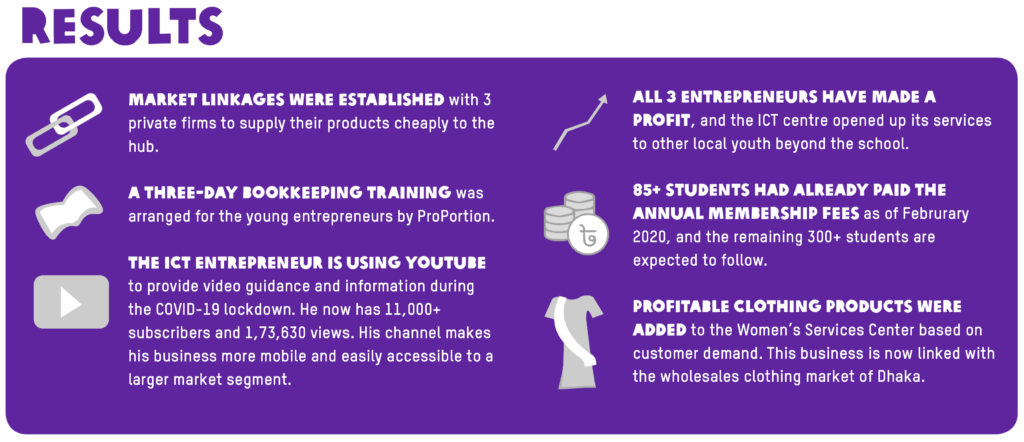Dishari Youth Hub: A pilot from Bangladesh
A youth hub is a physical space where rural youth can come together for various activities, such as skill trainings, discussions, access to resources and more. Through youth groups, young people are connected to the hubs to access capacity-building services for better employment and entrepreneurship. This concept has been piloted in Indonesia, Pakistan and Bangladesh.
The hubs in Bangladesh focus on local needs by setting up information services where youths can access services such as internet access, ICT trainings and employment information. The ‘Dishari Youth Hub’ is located inside a high school in Pairaband, Rangpur. The focus is on providing young rural entrepreneurs, high school- and college students, unemployed graduates and dropouts a networking and market access platform. The pilot officially started in September 2017.
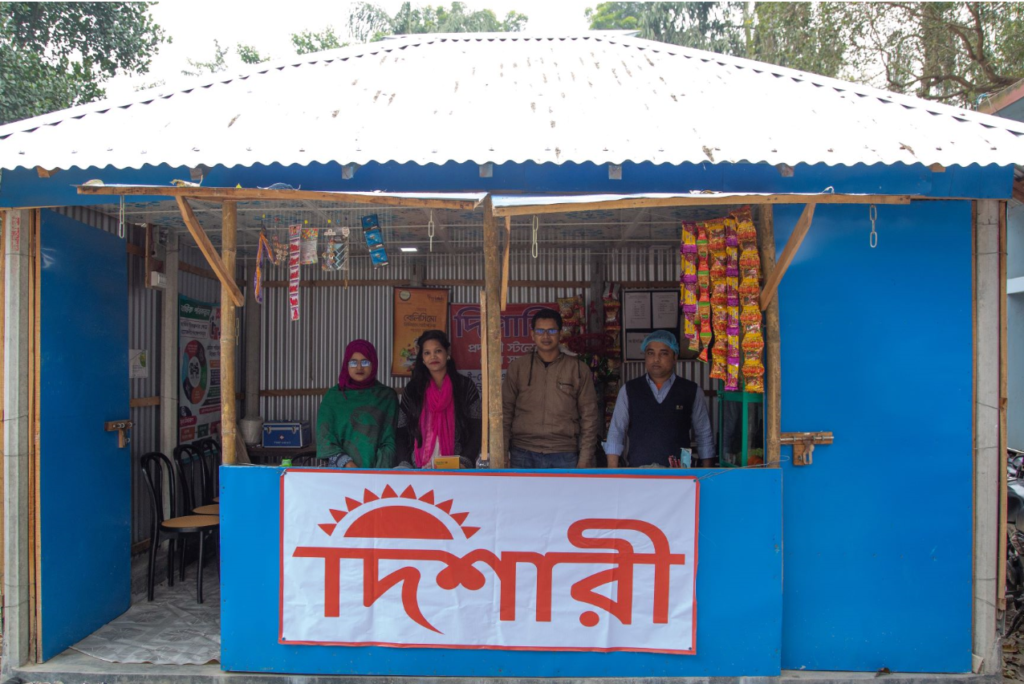
The Dishari Youth Hub functions as a co-operative business model and has two main components:
- The Student & Youth Collective: A democratically elected organisation run by and for the students and other youth. The rural youth who become members of the Collective by paying an annual membership fee will have the opportunity to participate in both the decision-making process and the operations of the hub itself. The members will have exclusive access to youth-centric services at a discounted price, providing easy access to products and services which would otherwise not be easily accessible or affordable. The membership fee will be used to operate and maintain the building infrastructure hosting these businesses.
- Youth-Centric Business Units: The Student & Youth Collective decides which youth-centric businesses and services to host at the hub. Currently, four young entrepreneurs run their businesses at the hub, all in different trades to avoid competition.
-
- Women’s Service Centre: Ran by two young women, offering cosmetic products, basic health products, blood pressure and weight measures.
- Food, Water and Stationary Retail Centre: Ran by a young man, selling freshly cooked food, beverages, books and stationery.
- ICT/Online Services and Training Centre: Ran by one young male teacher at the school, offering ICT skills training, academic coaching in ICT subjects, CV writing, and online services such as applying for college or jobs.
Why in this location?
In 2016 and 2017, almost 7.4 million Bangladeshi youth aged between 17 and 24 were unemployed or uneducated, of which 17% male and 83% female. Some of the barriers that the youth are experiencing are not having skills that match the labor market, a lack of safe transportation, and social and cultural norms restricting women to domestic responsibilities. Engaging with youth from the most marginalized rural communities can be especially challenging due to geographic distance and limited resources and opportunities. The establishment of youth hubs in these remote areas can offer great opportunities on different levels.
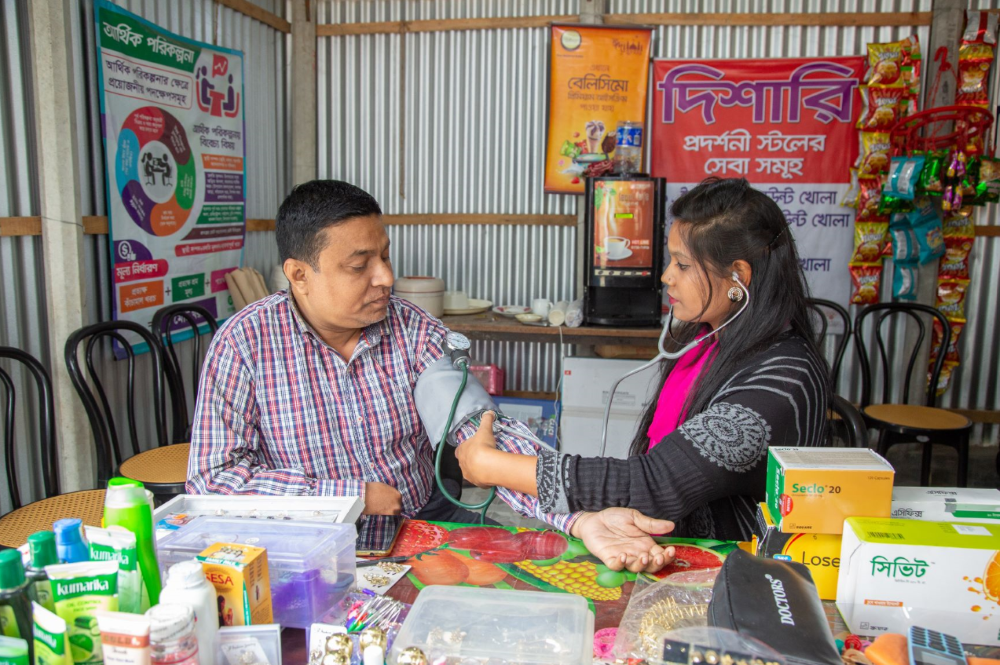
What makes this pilot innovative?
The adopting of a co-operative business and operational model for the youth hub will not only help rural youth get easy access to certain products and services, but also provide them with rich life experiences by offering various opportunities including participating in decision-making processes, taking up managerial responsibilities and also earning some money by volunteering to work as part of the operational crew at Dishari. The management committee of the youth hub will be trained in how to manage operations in order to and make it a more sustainable model.
Methodology
The pilot was co-created with youth and community members using the Human-Centered Design (HCD) methodology, guided by the consultant ProPortion, in the following steps:

1 & 2. Inception and Hearing (July 2017-September 2017): In this first phase, selected youth, implementing partners and Oxfam Bangladesh were introduced to the HCD methodology. During this, the problems related to the predefined pilot ideas were identified and decisions were made about collecting in-depth data using interviews.
3. Creation (October 2017-January 2018): In this phase, a local expert from ProPortion supported the participants in executing the field research. They gained insights by interviewing approximately 20-24 stakeholders. The data was analyzed, synthesizing innovative ideas that were desirable by the target youth groups. This resulted in four main design themes: relevance for youth, viability of the business, access to information and services and income generation opportunities for rural youth.
4. Delivery (February 2018 – August 2020): The concept idea was validated with multiple stakeholders (such as rural youth and entrepreneurs). The created concepts were scored on desirability, feasibility and viability, which resulted in choosing the concept of the Dishari Youth Service and Business Centre. It was later revised into a co-operative model to enable and empower participating rural youth with essential entrepreneurial skills that are needed to create and manage sustainable enterprises in the future. This creates an open platform for active inclusion of young women and men in social and economic development of their community.
5. Scale-up: The next step is for ProPortion to hand-over the model to the implementing partners. Currently, both parties and Oxfam are still in discussion on how the current model can be implemented as it was not able to be properly tested yet due to delay and the COVID-19 pandemic, and there were some challenges experienced within the model.
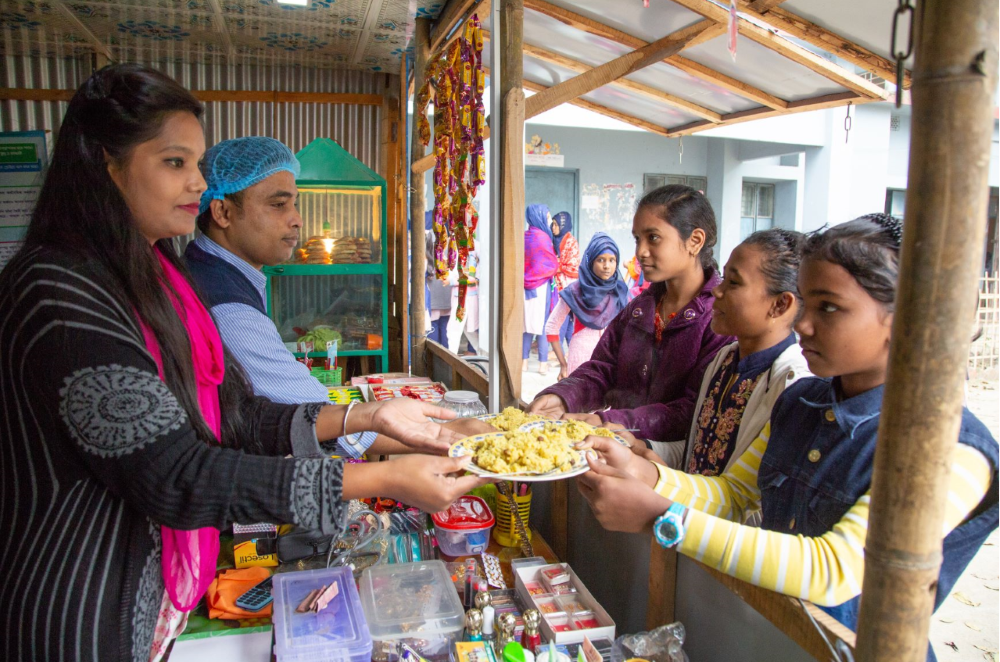
Lessons learned
- The designed Dishari Youth hub model was too complex, despite it looking very promising on paper. The usage of a common bank account, coupons and a steering committee was hard to realize, with too much emphasis on creating an entrepreneurial model. The main function of the hubs should be a place where youth can access different services and information and it being youth-led. This could be realized through a simpler model, as can be learned from the four hubs that youth have set up themselves.
- The location of the hubs is very important. Dishari was located inside of a school, meaning that the hub was only open during school hours. This doesn’t make it accessible to all youth, especially ones that are not students in this high school.
- Youth participation and selection is key. While EYW youth were active in the hub creation, the rural youth for whom this pilot is meant should have been more involved from the beginning. This would make the hubs more focused on their specific needs, rather than overemphasizing the entrepreneurial hub model. Additionally, the youths that were involved in the hub already had existing business, which can create lack of ownership towards the hub.
- Co-ownership and co-creation with youth and important stakeholders (e.g. local government, existing social groups, community) is key in creating sustainable hubs. This will create a sense of shared responsibility, and it is important to maintain these good relations between the youths and other stakeholders for gaining assets and success. The coordination between the consultant (ProPortion) and the implementing partners is also important in order to improve understanding from both sides.
- COVID-19 restrictions are limiting youth hub business activity. The general public are currently unable to purchase any products or services sold at the Dishari Business Centre/Hub, which is located inside the school premises (with entry restrictions) on a temporary basis. The young entrepreneurs have adapted to this by moving the ICT services online to YouTube and selling food products outside the school premises.
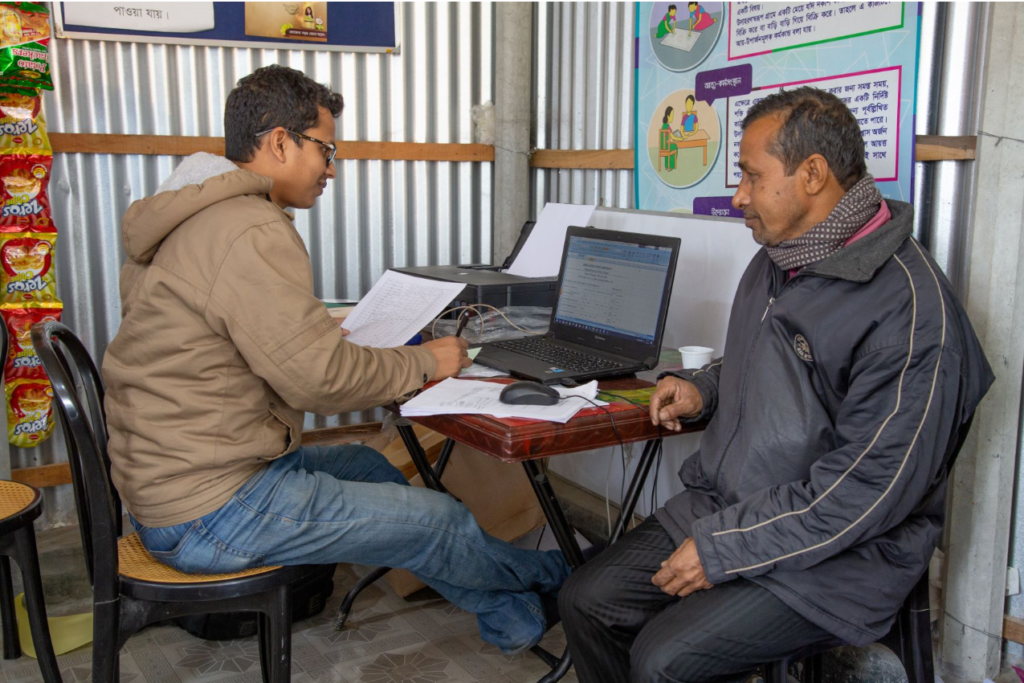
Youth taking hub creation into their own hands
An E-motive exchange with India was held to gain insights on how the Bangladesh team could create a community space, have safe mentoring and peer learning models, and safe mobility (especially for women). The youths that joined the exchange to India became inspired by seeing how information services specifically for young people could look like. Since January 2020 they have set up 4 others hubs by themselves, co-created with implementing partners and local government. The hubs are in Khulna, Rangpur, Barisal and Rajshahi. They shared the information that they learned during the exchange with other youths as well and have built the hubs from local resources (in Rajshahi, they even got a piece of land for free from the community elite). The services they are offering are regarding health (medication, selling sanitary napkins, and measuring blood pressure), and information on training and learning, by connecting it to information from the agriculture extension office from the government. The next plans are providing them with computers so they can access information to job employment and creating a linkage to the big market in order for youths to sell their products (e.g. vegetables and tailored clothes). This opportunity is especially promising to young women, as this allows them to gain income without having to travel far to the big markets to sell their products.
Sustainability and scaling
At the forefront of the sustainability strategy is that the hubs have to be youth-led and owned by the community and other important stakeholders, such as the local government and formal youth organization registered under government regulations.. The hub will have to be located at an area that can be accessed by all youth anytime. Making the hub a social enterprise by offering services in the hub by young entrepreneurs, such as lunch, snacks, beauty and hygiene (SRH) products, and ICT services, can make the hub sustainable. Important in this is that the products should meet the market needs.

